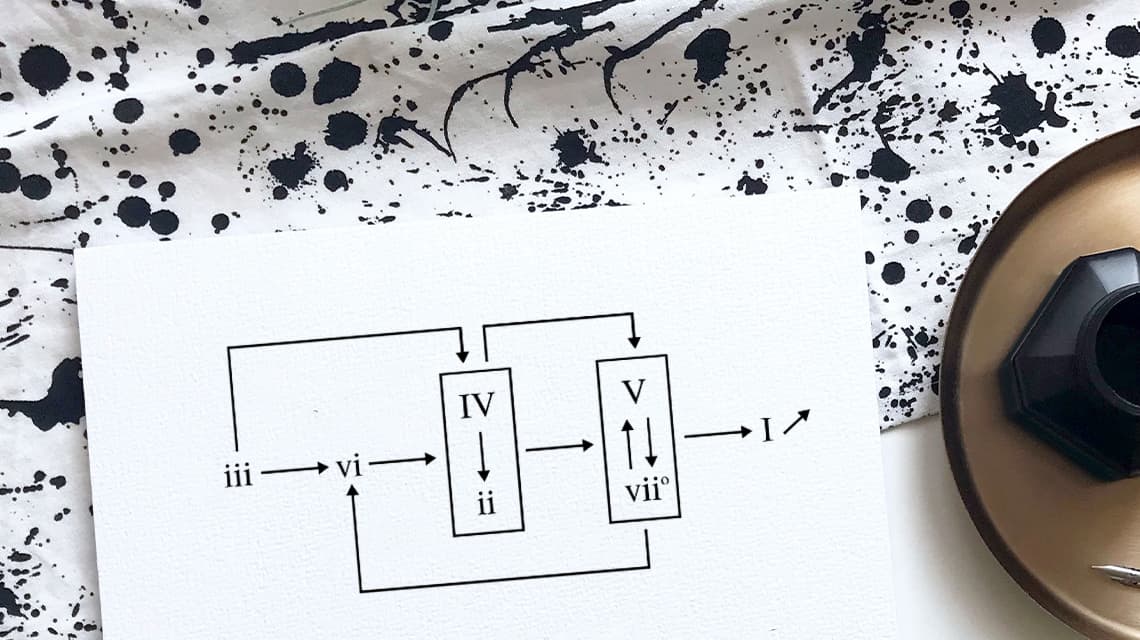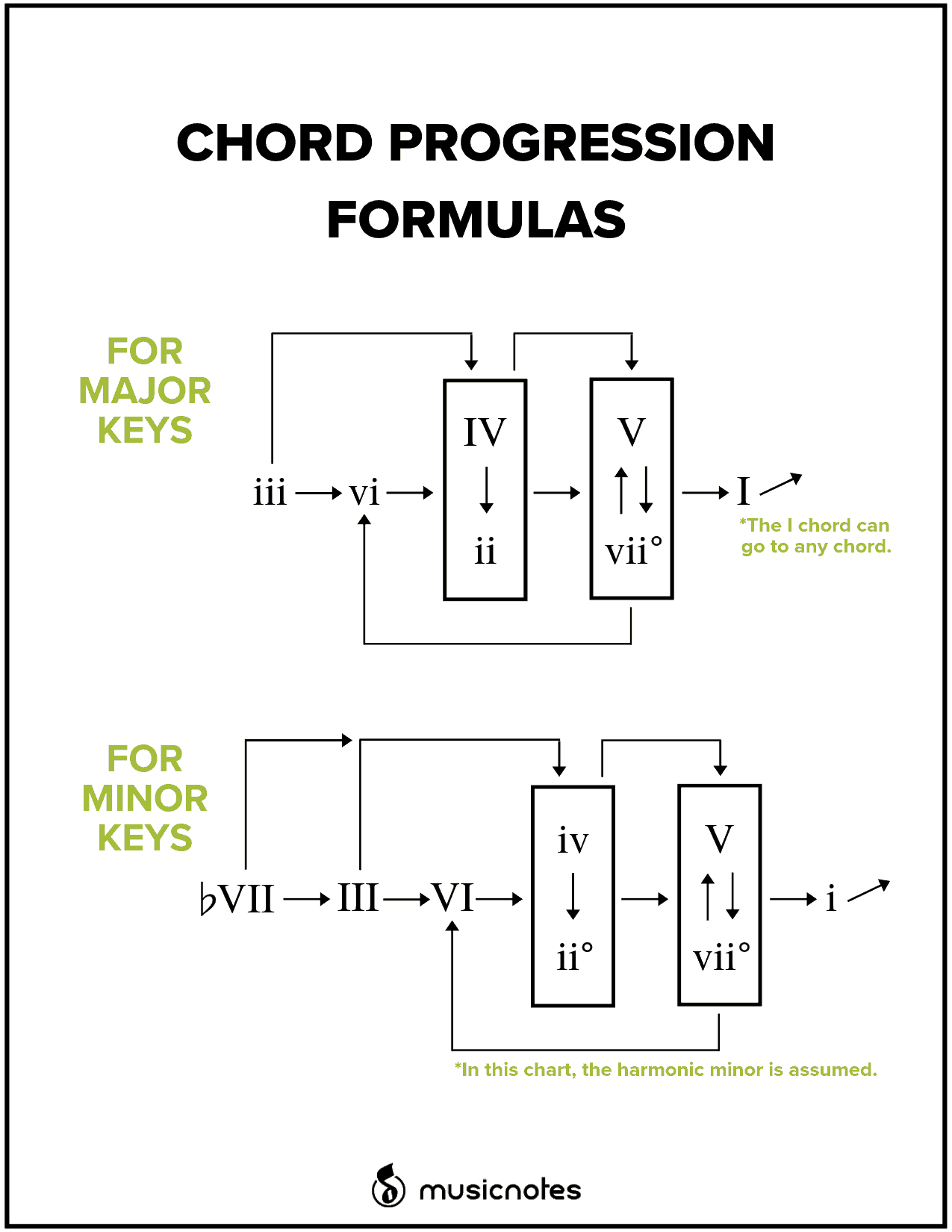How to Use Chord Progression Formulas in Music
Learn to use chord progression formulas and interpret them for major keys and minor keys using our in-depth guide and video.

At first glance, chord progression formulas can look like a really complicated math equation.
In fact, in ancient Greek and Roman schools, music was considered a branch of the mathematics curriculum. But don’t let that scare you away—harmonic progressions are actually simpler than you think!
Numbers are used to analyze all three of the major elements of music: rhythm, melodic intervals and harmony. For the latter, musicologists use both Roman and Arabic numerals.
In musical analysis, the Roman numeral is used to identify different chords, also known asharmonic structures, in relation to the key of a musical piece. The key signature is known as thetonic, which is like home base. So, if the song’s key signature contains one flat and it is in a major key, the tonic is F; if it is in minor, the tonic is D (minor and modal keys will be covered later on). The tonic chord is identified with the Roman numeral I. In the key of F major, the C major chord is labeled as V (also known as the dominant), since C is five notes up the scale from F. The Bb major chord is IV (subdominant), and so forth.
When applied to minor chords, lower case Roman numerals are used, so in our F major example, the D minor chord is called vi. If the tonic of the piece is in D minor, it would be considered a i chord. The reason for using Roman numerals in this manner is to use one system of identifying and analyzing harmonic structures across any key signature.
In harmonic analysis, Arabic numerals are used to analyze individual notes of a chord in relation to one another. If you study advanced music theory, you will run across labels that include a Roman numeral with one or more Arabic numerals stacked next to them. This indicates theinversion, or which note of the chord is on the bottom. So, an F major chord with F on the bottom isfirst inversion, or root position; if the bottom note is A, it is second inversion, while C on the bottom is third inversion.
This is advanced stuff that’s helpful to know, but you don’t need to remember it in order to use chord progressions.
We filmed a short video covering what these formulas are and how to use them, but before you watch, make sure you’ve brushed up on yourRoman numerals. These charts are illustrated with Roman numerals, and we’ve covered what these numbers represent in music inthis blog post.
Check out this video, and stick around to dive in deeper to chord progression formulas.
Let’s recap what we’ve just covered in more detail.
Remember, these formulas are not rules, but rather, tools. If you follow these roadmaps, you’re going to come up with chord progressions that sound very pleasant and natural. Let’s review the formula for major keys.

Remember the root movements we discussed in the video. These charts follow three common root movements: movement by 5th, by 3rd, or by step. These are commonly used in music because they’re very pleasant sounding. Remember, music is not limited to these root movements.

Let’s make it a little easier to look at by replacing the Roman numerals with the chords found in the key of C Major.

Now, looking at this chart, we can see the possibilities for different chord progressions. Here are just a few:
- C > em > am > F
- am > F > G > C
- C > am > F > dm
Remember, chord progressions are usually repeated several times. The last chord in your progression doesn’t necessarily have to follow the formula.
You may be wondering, why do I need to know this? Well, there are a few reasons!
- Music theory class. If you’re a music major or in any kind of music theory class, you will, without a doubt, encounter these charts.
- Music analysis. Let’s say you’re trying to analyze a particularly tricky progression in a piece of sheet music. This chart can be a huge help! If you’re stuck on a chord or two, the chart can aid you in which chord would make the most sense and help you put the pieces together.
- Writing your own music. If you’re a composer or aspiring to be a composer, this chart is great for getting started. Of course, as we said, you can certainly branch out from this formula, but this will give you a place to start. It can also be a great reference point if you get stuck.
And lastly, recall that the formula for minor keys is a little different.

The reason you see the major V chord and the diminished vii chord is because many songs written in minor keys make regular use of the harmonic (raised) seventh. Raising the seventh is what causes these chords, but if you’re writing in a natural minor key only, you will use the major VII chord found at the beginning of this chart, the major V would become minor, and there would be no diminished vii chord.
Before wrapping up, it’s worth taking a look at modal keys.
Chances are you’ve heard modal music all your life, but didn’t recognize it. Modes are common in folk music, Gregorian chant and many kinds of non-Western music. Sometimes, they’re even used in popular music; for example, the song ¡Tequila! is in a mode known as mixolydian.
An easy way to understand this is to play a C major scale with a Bb instead of B natural. Replace the E natural with Eb and it becomes dorian mode.
There are seven modes altogether (in the modal system, the regular major and minor keys are called ionian and aeolian, respectively). Modes are what musicians used back in the Middle Ages and early Renaissance before the development of the key signatures we use today. You may never consciously use them, but if you are interested in ancient and non-Western music, they can be handy to know.
We don’t expect you to have these memorized right away, so make sure to check out our free printable PDF of these formulas below!
Click here for your FREE printable PDF.

Want to analyze some sheet music with these formulas? Check out the world’s largest collection of digital sheet music at musicnotes.com!

